Pitmaster T
Babbling Farker
Chapter 9: The Legends of Texas BBQ, Tradition and the Audacity of the Shortcut
NOTHING FUNKY ‘BOUT THIS
NOTHING FUNKY ‘BOUT THIS
This started as a diversion about the book, Texas BBQ, Walsh and Jetton. I release it due to a thread about Oil workers and pits in a forum discussion at the BBQ Brethren.
Disclaimer:
I have wanted to talk about this and offer it for discussion and think it needs separate thread. I will hopefully link it from time to time along with other discussions and post whenever we enter into arguments over tradition and whose BBQ is "better."
It is a critical essay on Rob Walsh's excellent research on Jetton but also how he has fallen prey to the faults of primary documents. Those of you educated in History or some other discipline that uses critical thinking will see it as a critique. For those of you not attune to the study of history and critical thinking "critical" does not mean I am taking shots at someone, just analyzing a mistake they have made and explaining how an author has unknowingly erred. In addition, when publishing a book you are also at the mercy of your publisher and thus any alternative theories or explanations could be omitted against your will.
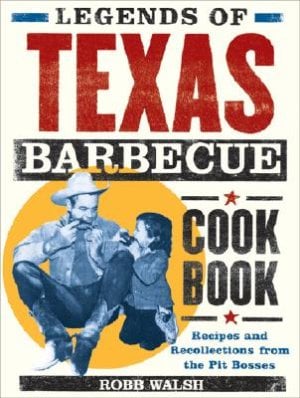
Legends of Texas Barbecue Cookbook, by Robb Walsh
I LOVE this book. I like Walsh's work (my favorite) but on page 33 there is an unintended error. I realize he misstated the time period Jetton actually cooked the meat on the fire as 18 to 24 hours. He did this probably because Jetton's stupid cookbook made adjustments to his recipes for reasons of accessibility and is now considered an historic primary document as to how he did trail Q as the countries first official pit master. The book was published in the 60's and gave the impression that his BBQ was cooked that long. Magazine articles from the time period are no help either. Also I will explain below what often DID get cooked that long - but was rarely eaten entirely at the event. Pay close attention, and I will give you probably the most closely guarded secret I have – one that someone used once and holds a trophy for from over a decade ago yet was illegal to use, and now, maybe not so illegal. Yes, this means several of us know someone “should” return the trophy. But I, for one ain’t a snitch that way.
The Titanic, Metacognition, Popular Consensus, Source Data and the Myths they can be Based on.
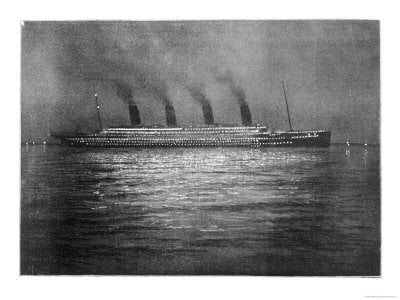
First let me give a small lesson in the metacoginitive (thinking about how you think) principles of History and how Walsh, through a trick in history, could have gotten to this point. I cite the sinking of the Titanic and the fact it broke in half (as discovered in the 80’s) and why for nearly 70 years it was thought it sunk in one piece. The truth of the matter was many actually SAW the Titanic break in half but the inquiries held in America and England chose not to focus on the ones that made this claim because the interests of the governments and the businesses that were entangled with them governed how the questions were asked.
The Titanic was a British REGISTERED ship BUT OWNED WHOLELY by the International Mercantile Marine of the American Financier J. Pierpont Morgan. As we all know it sunk after running into an iceberg in April 1912. It was insured by Lloyd’s of London. If the ship was known to have broken in half and sunk it would have been seen as “defective” and coupled with the mistakes committed by the shipping line in terms of navigation, as well as the obvious inadequacies of the British Board of Trade (which deemed it perfectly acceptable to only have a fraction of lifeboats aboard) then all hell would have broken loose.
The huge amounts of public confidence in British and Irish Shipbuilding, as well as one of Britain’s (and American) shipping companies would have been destroyed. Simply put, Lloyd would cover fully acts of God not negligence or Harland and Wolfe’s Shipyard’s defect in design. The official result placed more blame on Nature and a few personalities such as the owner of the line, the Captain (who was dead) and the Californian, a ship that was a mere 10 miles away, whose radio operator was asleep and whose crew saw the rockets and did not respond. Even Walter Lord Himself, who wrote the first great study of the Titanic disaster, Night to Remember, fell into the trap as he interviewed survivors and ignored claims that it broke in two by suggesting it was things that slid down in the ship towards the bow that made that horrible noise. In the 1980s the Titanic was found in two pieces and further scientific study confirmed it broke in two on the surface. Nearly every book about it written before got it wrong. In addition, in the authors’ zeal to tell their story, the controversy of opening up that issue was ignored. However, buried in the official Inquiries testimony is the evidence and even drawings by a Jack Thayer of the liner breaking in two. By 1913, though, the myth was cast.
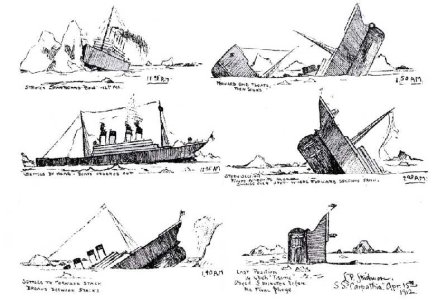
Jack Thayer's Drawing of a Split Titanic (1912)
In history (I have a B.A in History) we come across these kinds of mistakes all the time. Often we perpetuate it by further adding to the folklore by citing works written in the past as the gospel. This is why history at times must be REVISED. Historical revision is not the boogey man Newt made it out to be in the 1990’s. New evidence is found or new explanations are given. In addition, one has to remember the climate things are written in.
Taboo One - Just tell me what's in it dammit! What? No way! That’s in it? – Are you ****ting me!
We often are fully aware that how a person REALLY cooks and how what is placed online or in a book can differ. I think I cited once before what REALLY went into Mikiskas sauce and rub on a Bobby Flay VIDEO show once was ENTIRELY different from what was posted as the recipe on the Food TV cite.
Once I was asked to make my Baked Beans because they were so good. When I told the lady what was in them (one pound of Brown Sugar to each number 10 can after it was drained) she balked and refused to let me make them that way, even though moments before she had loved them. Now, all of the sudden they were too sweet.
Health concerns, rules, taboos, and making the recipe accessible to the chef at home are all taken into consideration. This is one reason why Jetton’s own 1965 cookbook can be misleading.
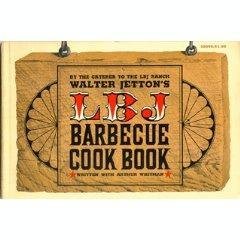
The Cookbook in Question
Taboo Two - True Mop STOCK A delicious Shortcut
As someone who saw Jetton's Family Business (before it shut down for good) actually do a cookout for my grandfather's Company (Texas Electric Service Company) in 1972 (yes, after he died) and who was befriended as a little guy by his Mexican pit master apprentice (then the master after Jetton died), and who still has contacts with his family, I personally know that Jetton, who used to cook whole quarters and simmered them in a ROBUST stock first before he grilled them slowly over that fire, did nothing different when he switched to briskets round about the time of the end of the Mercury program.
Taboo Three – They have been out there doing something for Damn near a day! But why can't I Eat off this Side of Beef Again?
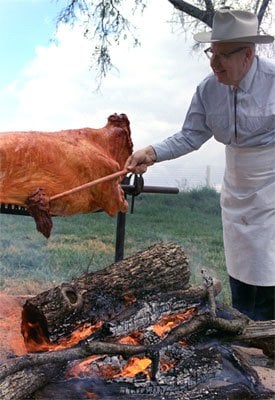
Jetton and his Spit
The ONLY thing Jetton cooked anywhere near that long was the trademark side of beef on a spit he used and that was for show mostly. Later it would be broken down into usable chunks of beef after the premium cuts which could be served more rare were given up.
The Pits ACTUALLY TOOK DAMN NEAR a good 10 hours to both dig and get right. For instance, the pit was 3-4 feet deep (varied due to total number of people and water table as in the case of were I live - near Nasa in Houston) and stacked to the top with wood. When that burned down to coals he was ready to cook on it. BY coals I mean not a lick of fire or unburned wood anywhere. Kerosene and pallet pieces were used to light it. YEP!
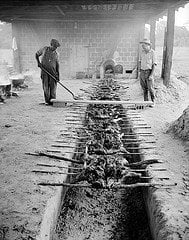
Typical Pit (Not Jettons)
The ILLUSION was that they had been COOKING from the night before when in actuality they had been prepping and cooking for all that time. From the payer's standpoint they could give a chit how it was made, they just saw SOMEONE toiling for a day from digging the pit to serving it up. From the eaters’ point of view - well who cared?
The party I was at was at Trinity Park in Fort Worth. My grandfather was VP of Texas Electric. For a BIG party (like 500 or more) where a side of beef was not practical, the way it went down was this. The pit was dug, wood was stacked into the pit above the ground level, fire was lit and at some point in time huge pots were placed over the fire and filled with water, salt, lots of pepper, lots of Bay Leaves, bones and whatever scullery items they had left (onion peels, celery scraps, garlic pods and such.)
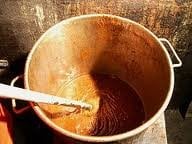
Typical Grubby Dirty Mop
Quarters first then briskets were put on if he was doing any. These were simmered covered until the beef was pretty much done but had a way to go for tenderness. This process is identical to the trailheads process. In fact, on a trail, the cook would merely simmer the cuts in the same type of flavorful concoction then actually just set it aside. When the hands got to the camp CEDAR (anyone who KNOWS where the trail is knows what wood is indigenous to the area) was placed on the fire and the meat was placed on to heat up quickly. Yes Cedar. Think of the properties you know of burning cedar and you will see how it can be used to flavor meat quickly.
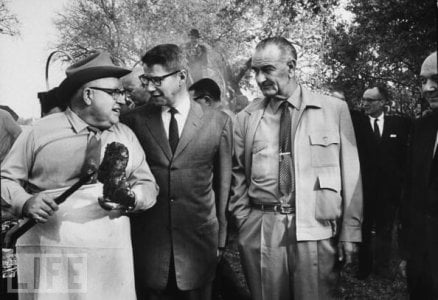
Jetton with a HALF a brisket?
Back to Jetton, I imagine the natural next shortcut was he may have also just added the powdered items shown in his Mop recipe on Page 141 to impregnate the meat with his flavor and as a shortcut but I cannot confirm. If not he added it when he was through simmering the cuts.
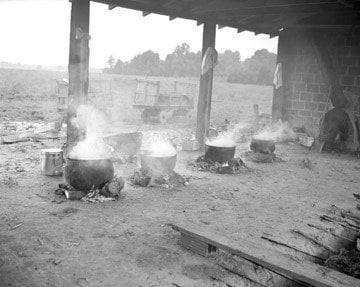
Same Shot as above but left - What do you Simmer it in Again?
People always say simmering is stupid because you remove the flavor from the meat and put it in the stock. Sure, when it’s just water. I always laugh at this assumption because in using linear logic when we apply this rule to marinades no one offers up the difference between placing meat to marinade in water (which I oddly enough do with my vacuumed pork tenderloins) and how it is the same as marinating in say, soy sauce. But the “simmering” taboo seems to escape the importance and delineation of what is actually IN the liquid. In Jetton’s case, it is not so when you throw meat in a stock already made from bones and a load of other flavors. PLUS, as you go, the stock gets more flavorful. Now imagine mopping a pre impregnated with flavor cut of beef with this chit as it builds a bark and caramelizes for about as long as it takes to smoke a set of spares over the coals. Imagine!
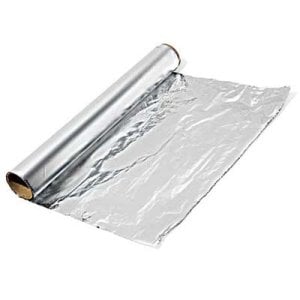
Foil
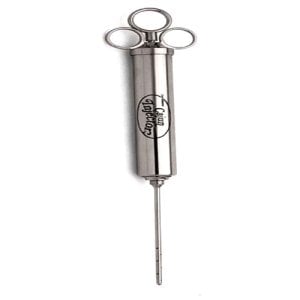
Injections
Taboo Four - The Audacity of the Shortcut
The ribs were shortly simmered (maybe 12 minutes) SOMETIMES and all cuts were seasoned and put on a few hours before the arrival. When people arrived they were usually greeted by Jetton on a meticulously decorated and delicious looking half of beef on a spit, hundreds of pounds of meat on the pit and workers tending the flare ups (that was my job I got as the grandson of the guy paying for the BBQ) and a pit master flipping the meats and another mopping the cuts with the contents of the incredible mop which was made of the beef stock he just USED (to which simmering the bones AND the meats in for quite a while served to make even more robust) was modified with the seasoning you see on Page 141 of the Walsh Book. I will also note the mop in the book lacks lemon halves.
The truth is - all some of us have actually done over these last couple of decades has been trying to emulate THAT flavor with the apparatus we use today and do this within a certain set of rules given to us by the internet. Foiling, for instance, is nothing but merely braising the meat in its already quite robust collection of flavors – of course part of braising is merely simmering in a closed environment – the simmering liquid ends up as a collection of the beef drippings, your rub, the smoke and results of the maillard reaction.
WE have seen on the brethren confirmation that at even the famous Salt Lick in Austin tradition is circumnavigated by pit oven the cuts before hand and placing them on the age old pit in the dinning facility for Show and to apply that special mop and bark to their modern pre-smoked cuts.
Smoke a set of spares at 300 without wrapping or mopping and you get a juicy set of ribs. Lower that temp to 225 and typically you get a dried out set unless you 3-2-1 it. But now the bark is sacrificed? What to do? Pass the sugar. A shortcut is born. Not to say it’s a bad thing – just another way.
Add to that the INTERNET driven taboo that claims simmering meat as “untraditional” when the TRUE story is MANY different people (ONCE BBQ BECAME A BUSINESS OR A WAY TO FEED TRAILHANDS AT THE END OF A RIDE) sought these shortcuts which often exceeded the flavor of NOT using them. This drive is WHY WE INJECT; to add flavor and retain moisture. Funny how something as traditional as simmering meat in a pot can be seen as untraditional while picking up a syringe and placing canned or powdered ingredients into the cut is not. Perhaps it is because KCBS and other Orgs forbid it. Oh, I am THIS close to telling the whole world about my secret injection. But this paragraph is dedicated to the poster who may want to defend that their regional style was never simmered. This can also be true. But may I remind you that if it were not for shortcuts or alternative methods there would be no VINEGAR PIE!
Taboo Five - Shortcuts can be a delicious Natural Progression of Cooking at times
Jetton followed the same path as many of us old smokers do when serving lots of people. I don't want to say we “cut corners,” as that denotes reduction in quality. But when you are paying labor or stacking up the jobs you need to get in and out, yet still create a good impression. You have to make adjustments. I used to make my mashed potatoes al naturale. Now, I make my mashed potatoes with half instant and the other half boiled potatoes with skins on. The instructions call for boiled water so I just make the whole dish better by boiling water with potatoes already in it and mash them up and add. People think I spent all day. Jetton was the same as he got older. He started at a time when he could get cheap labor and there was no way to just buy 300 brisket flats. As times changed, labor laws enforced, health codes were enforced and business took off he took advantage of the advances in meat packing logistics by using brisket for the dough (self basting and cheap) and the rustic cuts for the show.
What is so sad here is that we are so discriminatory about "simmering" cuts that no one even DARES mention it online for fear of vehement ridicule or calling into question their expertise on anything else. Truth be told, the party goers never knew (or cared) about where the MOP came from really or how the process went on. I guarantee to you, if you were ever fortunate enough to be at one of these WHERE IT WAS SIMMERED - your jaw would fall to the floor. Of course, not even the reenactments each year in Fredricksburg get this little thing right, even though they know it happened. Too many people would flip out.
Finally, I would like to bring in some of the observations from another book by the Legend, Mike Mills. In his travels across the US looking for great Que he humorously pokes fun at us in his chapter, BBQ Police. He also tells a story about trying to have test kitchens make his grandmother famous and illusive potato salad only to find she copied it from the mayonaisse jar. I would like to mention that some of the great Q he tasted broke the “rules.” For instance, years ago Myron’s injection would be seen as taboo, Gonzales Market’s Pan Fried (essentially) BBQ beef ribs is regarded as “stellar: in both our views but not traditional, Kreuz’s clod or brisket is anything but low and slow, three barbecue barons inside list their sauces as being vinegar, mayonnaise or mustard based (not commonly accepted in most every other region where tomato is king and that’s damn near everywhere). We have one guy who smokes his brisket, wraps them in plastic, chills them and then reheats in the oven in plastic to force the flavor and juices IN and one old guy who smokes, foils, chills, then reasons and DEEP FRYS his ribs to order. Hmm, it seems like SOMEBODY’s tradition could be another person’s taboo but it sure might be tasty.
So – about that brisket injection….

